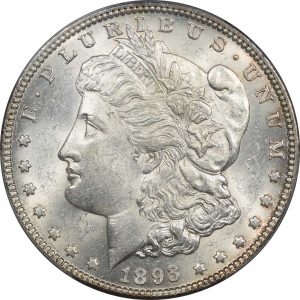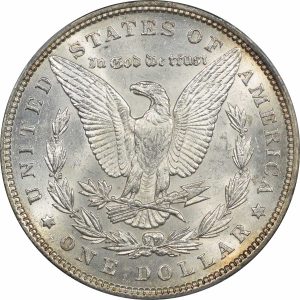Better Date Mint State Morgan Dollars – A Current Market Perspective

 by Robert Lehmann
by Robert Lehmann
Morgan Dollars have always been one of the backbones of the numismatic marketplace. It seems as Morgans go, so goes the overall market. This certainly has held true for generic, mint-state dollars. Generics are defined as coins that derive their value from grade, irrespective of date. 1879-1882-S, 1883-85-O and 1885-1887-P are a few of the more available “generic” date ranges that come to mind. Because certified quantities of these dates are readily available, they have always been a favorite of dealers and collectors. One cannot deny that the present state of the dollar market is healthy. But, is it really the generic sector that is leading this area of the coin market?
Although MS-65 through MS-67 generic Morgan Dollar prices have remained somewhat steady, this area is by no means bullish. Most of these coins are trading for less than they did during 2010-2012. However, true better-date, MS, certified Morgan Dollars have been red-hot. Many dates are largely unavailable at present. Even in the basal grade of MS-60, these coins are being chased by unprecedented numbers of dealers and collectors. As a market-maker in this series, I have an understanding about the scarcity, desirability and marketability of this area, so let’s examine all three.
To understand this area of the market, it is first necessary to define it. Here is my short list of true better-date Morgan Dollars, all coins which are legitimately tough to locate in PCGS/NGC-certified grades of MS-60 or above (with some being downright rare): 1879-CC (Capped and Regular), 1883-S, 1884-S, 1886-O, 1889-CC, 1892-CC, 1892-S, 1893, 1893-CC, 1893-O, 1893-S, 1894, 1894-O, 1894-S, 1895, 1895-O, 1895-S, 1896-O, 1896-S, 1897-O, 1901, 1903-S and 1904-S. There are several second-tier Redfield dates which almost made the list, such as 1885-S through 1889-S, 1898-S through 1902-S, 1890-CC and 1891-CC1. But for one reason or another, I felt these dates were less deserving.
In general, I find that there is a loose interpretation of what exactly constitutes a better-date Morgan Dollar. I have heard dealers refer to 1880 through 1885-CC dollars as better-dates. Although these Carson City cartwheels are certainly popular, in terms of rarity, they are by no means better. The same holds true for dates like 1878-S, 1881-O, 1882, 1882-O, 1884, 1888-O, 1890, 1890-O, 1897 and 1903. Some of these dates get conditionally scarce in grades of MS-64 and above, but none are really better dates. All exist in bag quantities, and average uncirculated specimens can be obtained relatively inexpensively, in roll quantities, and generally, on a moment’s notice.
Scarcity
Volumes have been written on date-by-date analysis of Morgan Dollars, and to evaluate each and every date for its particular merits is not my goal. Treating the above group as a whole, let me try to define scarcity and what it means in today’s numismatic marketplace.
Scarcity is not simply a coefficient of the number of a particular coin graded by PCGS or NGC, but rather a supply and demand curve of how many available coins exist verses the potential customers trying to obtain them. For example, there are approximately 3600 mint state 1886-O dollars graded between PCGS and NGC. This may seem like a large number, but when considering the collector base for Morgan Dollars, it actually is not. One abstract aspect of scarcity is that it is relative. Using the above example, there are potentially tens of thousands of Morgan Dollar collectors chasing a mere 3600 coins. Compare this to a rare dated gold coin where there may be less than a hundred known (The $5.00 and $10.00 Liberty series are both full of these type of dates), but only a handful of potential customers trying to procure them. Although the gold coin may be rarer in sheer numbers, the relative scarcity favors the 1886-O. I will take this a step further. By comparison, over 260,000 mint-state 1880-S Morgan Dollars have been graded between the two services. In other words, an 1886-O Morgan Dollar in a PCGS/NGC-certified mint state holder is 72 times as scarce as its 1880-S counterpart. Using this methodology, is a certified 1886-O Morgan Dollar in MS-60 undervalued at a wholesale bid of $875.00?1 When examining the 1880-S in the same grade with a wholesale bid of $46.002, the price correlation to available supply also heavily favors the 1886-O. This is yet another aspect of scarcity to examine, and it too, is relative.
Since it is my firm’s $875.00 MS-60 bid that the Coin Dealer Newsletter is presently reporting, I believe wholeheartedly in this date and its legitimate scarcity. I would make the same argument for every other date on my list above. In short, these all pass the scarcity litmus test; their populations are far less than what their corresponding bids indicate these dates should be worth. Perhaps more importantly, the mint state supply of these dates does not satisfy the present market demand, which is the true ultimate test of scarcity.
Desirability
Desirability is both subjective and difficult to quantify. However, as a full time dealer with over 30 years of experience, I am exposed to this area constantly. If a coin appears on collectors and dealers want list repeatedly, in short, it is desirable. This is a shared trait for each and every date of Morgan Dollar on my above better-date list. I recently had a customer call me requesting an 1893-O Morgan Dollar graded MS-63 by either PCGS or NGC. Despite increasing my bid to $5900.00, I still have not produced a coin for him. He is not an overly picky buyer, and nor in this instance, am I. It’s simply a matter of finding a coin that is being perceived as more desirable than my present offer to buy one. With 463 pieces currently graded MS-63 between the two services3, somebody unfamiliar with this series might get the impression that this date is overvalued. Without fielding phone calls, working want lists, attending coin shows regularly, and interacting with customers on a daily basis, it can be difficult distinguishing the more desirable from less desirable coins.
Marketability
As a market-maker in better-date Morgan Dollars, I realize that I’m not only out there on a constant treasure hunt, but I’m also being looked upon by my peers to support my market. Consequently, I make a point of stocking the dates of Morgan Dollars that I am also trying to buy. As challenging as this can be at times, it has also proven invaluable for buying. This is especially true at coin shows, where my inventory often dictates what I am offered. With proper inventory control and point-of-sale programs, it is not difficult to track the marketability of any coin. I know from first-hand experience that the shelf life of most better-date Morgan Dollars is brief. There is an old saying in the coin business that a good coin is a sold coin. In this regard, and from a general marketability perspective, better-date Morgans just may reign as king of their numismatic domain.
Scarcity, desirability and marketability are the three forces that drive the better date dollar market. Being able to identify a true better date dollar and then apply how each of these components influence its price, is how one begins to understand this symbiotic relationship.
Morgan Dollar collectors exist at all levels, from introductory to advanced. Often, this is one of the first series that piques a collector’s interest; the coins offer beauty, size and age, all in an obtainable and relatively affordable package. Today’s collector who gets hooked on the allure of a gem 1880-S dollar may become tomorrow’s collector who will try to complete a high-grade Morgan Dollar set. This constantly evolving demographic has put unprecedented pressure on all of the aforementioned better dates. The challenge of locating enough coins to satisfy their growing appetite is what keeps this business interesting.

